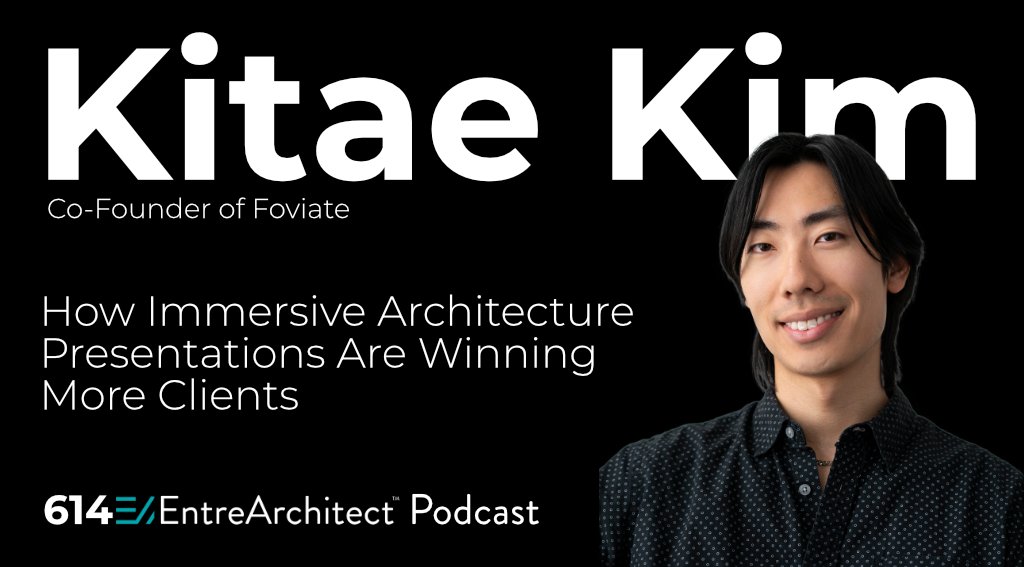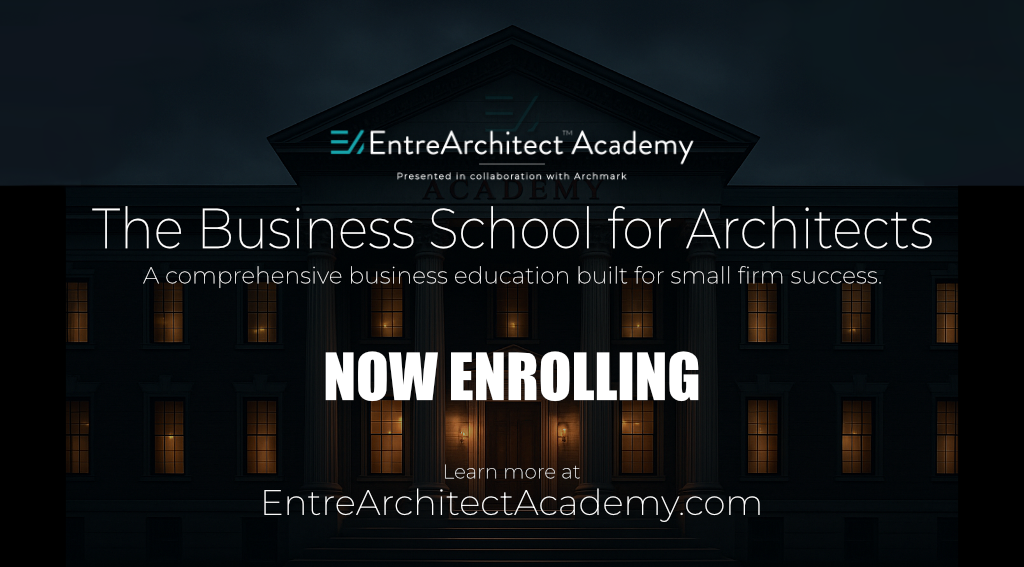
If you’ve ever poured hours into a beautiful set of drawings, sent it off to a prospective client, and heard nothing back… you’re not alone.
Most architects believe that great work sells itself. We think a sleek render or a polished PDF is enough to win the job. But today’s clients—non-architects, mind you—aren’t just looking for pretty pictures. They want to feel what the space will be like. They want to trust that you understand them and can bring their vision to life.
In a recent conversation with Kitae Kim on the EntreArchitect Podcast, I was reminded just how broken our presentation process is as architects. Kitae’s career, which began at the intersection of art and architecture, has taken him from immersive public installations to co-founding Foviate, a tool built to help designers pitch their creative work more effectively.
And the results? Where most architects win about 20% of their proposals, Kitae’s immersive, experiential presentations win over 80%.
Let’s dig into what we can learn from his journey—and how small firm architects like you and me can apply these lessons today.
From Art to Architecture to Experiential Design
Kitae didn’t set out to become an architect in the traditional sense. His early passion for drawing and sculpture led him through art school, then into architecture, and eventually into a role that straddled both worlds. After cold-emailing renowned media artist Rafael Lozano-Hemmer, Kitae landed a job working on large-scale interactive public art installations—projects that demanded spatial thinking but weren’t constrained by traditional architecture.
It was there that he discovered a deep flaw in the way we pitch creative work. Despite designing spatial, sensory-rich installations, the team was still relying on outdated tools like static PDFs and Photoshop mockups to communicate complex ideas. The medium didn’t match the message.
Sound familiar?
What Architecture Clients Really Want
We often assume that clients want beautiful images. But as Kitae points out, most clients aren’t spatial thinkers. They can’t interpret plans and sections. They don’t know how big “three feet” really is. And they certainly can’t stitch together a narrative from a collection of 2D images and text.
Whether you’re designing a home, a museum installation, or a commercial office, your client wants to understand how it’s going to feel to be there. They want clarity, confidence, and trust.
And trust, Kitae says, is built through experience.
That’s why his team started using virtual reality to pitch their work. Clients would visit the studio, don a headset, and walk through a full-scale interactive model of the proposed installation. They didn’t have to imagine what it would be like—they experienced it. And because of that, they believed it could be done.
That’s where the win rate jumped. From 20% to 80%.
Immersive Presentations as a Business Tool
This idea of “immersive pitching” became the foundation for Foviate, the platform Kitae co-founded after the pandemic made travel—and in-person VR—impossible. He realized that architecture firms didn’t just need better design tools. They needed better business tools—tools that help you win work.
Foviate lets architects upload a 3D model from tools like SketchUp, Revit, or Rhino, and turn it into an interactive web-based presentation. It’s like a slide deck—but instead of flipping through images, the client is moving through a curated spatial experience.
You choose the camera angles. You add annotations. You attach renders, PDFs, and diagrams directly to those spatial moments. And you control the story.
Even better, your clients don’t need any software. They don’t need to be tech-savvy. They just click a link—on any device—and walk through the space.
It’s simple. It’s intuitive. And it builds trust.
Controlling the Narrative
One of the most powerful aspects of Foviate is that it puts the architect back in control of the narrative. In architecture school, we learned to explain and defend our designs in front of a jury. But somewhere along the way, that skill gets lost. We default to cold, technical documentation—leaving the story up to the client’s imagination.
Foviate allows you to become the narrator again.
Whether live (using present mode) or asynchronously (like a self-guided tour), you can walk your client through the story of the design, one moment at a time. It’s not about overwhelming them with options or raw data. It’s about leading them through an experience—just like you designed it.
And in doing so, you eliminate confusion. You eliminate the guesswork. You eliminate doubt.
You replace all that with clarity, confidence, and trust.
Why This Matters for Small Firm Architects
If you’re a small firm owner, you probably don’t have a dedicated sales team. You are the sales team. And if your proposal materials aren’t compelling—if they don’t clearly communicate your value—you’re leaving opportunity on the table.
Think about the time and energy you invest in each proposal. Think about the cost of not winning that work. And think about how many times your great ideas have gone unrealized because the client just couldn’t see it.
Immersive architecture presentations aren’t just a flashy gimmick. They’re a way to dramatically improve your chances of winning the projects you want most.
Even if you don’t use VR. Even if you don’t use Foviate (yet). The core lesson here is this:
How you present your work is just as important as the work itself.
Build Your Brand, Share Your Process
Kitae also shared two low-cost, high-impact strategies that any small firm architect can implement immediately:
- Develop a Distinct Style (aka Brand) When you look at a Zaha Hadid project, you know it’s Zaha. Your firm should aspire to that level of clarity. A recognizable style builds trust and attracts clients who resonate with your values.
- Show Your Work (on Social) Don’t just post finished projects. Share your process. Document your thinking. Post videos of how you sketch or model or make decisions. Not only does this demystify your process for potential clients—it warms them up and builds connection before you even meet.
And when you’re ready to present that finished idea? Don’t let it die on a page. Let it come alive.
Final Thought
As Kitae put it, architects were trained to shape space—and through it, to shape people and relationships. That’s our superpower.
But if we’re still relying on static documents and outdated tools to communicate that power, we’re doing a disservice not just to ourselves, but to the clients we serve.
So the next time you pitch a project, ask yourself: Am I asking them to imagine it—or am I helping them experience it?
Listen to the full conversation with Kitae Kim on the EntreArchitect Podcast at https://entrearchitect.com/614.

Leave a Reply